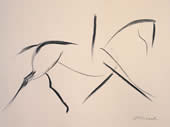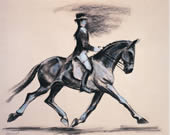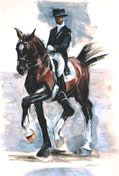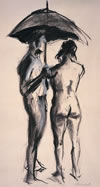|

|
A Selection of Giclee Prints
(click on image to enlarge and view prices)
|
|
|

Simple Line Drawing
Charcoal Drawing and Giclee Print
15" x 20"
|
|

Spencer
Charcoal Drawing and Giclee Print
30" x 35"
|

Dressage Study I
Mixed media and Giclee Print
31" x 21" |

Eliza
Charcoal Drawing
39.5" x 16" |

Hand on Cheek
Charcoal Drawing
33" x 17"
|

Hand on Cheek
Charcoal Drawing
33" x 17" |

Eliza II
Charcoal Drawing
32.5" x 16.5"
|
 |
Introduction
|
|
Giclée is a relatively new reproduction process for
fine art which is based on digital technology. The term Giclée (pronounced,
jhee'clay) was, reputedly, first coined by Jack Duganne in 1991, and derived
from the French verb 'to squirt or spurt'. 'Giclée' offers an exciting
new medium for both artists and photographers because of its unparalleled
quality. A Giclée printer squirts approximately 4 million microscopic
droplets of archival quality ink per second onto cotton canvas or paper
(or other media). The resolution achieved using this technology is much
better than lithography and the print should possess archival standards
of permanence comparable or better than other collectable artwork.
Giclée has rapidly become the most popular fine art
reproduction technique in the modern art world taking over from lithographs
and screen prints as the dominant and preferred way for artists, galleries
and publishers to make reproductions and prints. Giclée prints are now
widely accepted at museums and galleries. These include: the Metropolitan
Museum of Art (New York), the Guggenheim (New York) and The Smithsonian
Institute.
Quality
Giclée prints lose none of the quality of the original.
Because no screens are used, the prints have a higher apparent resolution
than lithographs providing an image of exceptional clarity. The visual quality
of the print result is extremely high with seeming continuous tone prints
and it goes without saying there are no visible dots, lines or barring.
The colour saturation and definition can be stunning yet none of the subtlety
of even soft pastel originals is lost - all of the texture and technique
of the originals are retained. Giclée fine art prints achieve the look and
feel of an original piece of art.
The technology, however, calls for special equipment
and techniques to obtain the ultimate in colour accuracy, sharpness, continuous
colour tone and life. To achieve its potential only the best inks and
papers must be used. Furthermore artistic interpretation in implementation
is necessary for the production of the highest quality prints - the selection
process for our printers has been painstaking and the work is vetted at
every stage.
Durability
A question one you may well ask is how well do the prints
last when on display. Recent tests show that a Giclée print can achieve
light fast capabilities in excess of 100 years and, when printed on good
quality heavyweight art paper, the print should possess archival standards
of permanence comparable or better than other collectable artwork. Giclée
prints are recognised by the Fine Art Trade Guild.
But what do we mean by lightfast and how do we measure
it? The scale commonly used today is the "Blue Wool Scale" (BWS) which
was accredited a British Standard (BS1006), and has been adopted as an
International Standard (ISO), although there is still work going on to
try and improve this standard. The Blue Wool Scale consists of samples
of Blue Wool dyed with various dyes, the best being 8; this is considered
to be permanent. The Blue Wool Scale was originally developed for textiles
and has now been adopted by automotive, paint and commercial printing
industries. A blue wool value of 8 equals about 12 months of direct sunlight
exposure in Florida without colour shift.
The Fine Art Trade Guild's Standard requires a minimum
Blue Wool Scale rating of 6 for lightfastness. The Fine Art Trade Guild's
Standard also defines requirements for the paper including pH values (a
measure of acidity) between 7 and 9 (BS 1006 / ISO 9001 spec. DIN 6738
/ ISO 9706). The Guild Standard has been in use for many years and is
now incorporated into BS 7876:1996.
Handling and Care
Although the latest research shows that with normal
use, the Giclée prints can last over 100 years it is suggested that you
treat each print the way you would treat an original (no direct sunlight,
care with fingerprints, etc.). That way, you can't go wrong.

|

